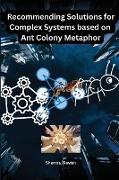- Start
- Recommending solutions for complex systems based on ant colony metaphor
Recommending solutions for complex systems based on ant colony metaphor
Angebote / Angebote:
An aggregation of animals of similar size and body orientation, generally cruising in the same direction is termed as swarm. 'Swarm behaviour' or 'swarming' is a collective behaviour exhibited by swarms to accomplish difficult tasks in dynamic and diverse environments without any central co-ordination. Examples of biological swarming are found in ant colonies, termite moulds, bee hives, fish schools and bird flocks which exhibit complex collective behavior despite the simplicity of the individuals that make up the swarm. Swarm Intelligence is an Artificial Intelligence technique based around the study of collective behavior in decentralized, self-organized systems which originally took its inspiration from the biological examples provided by social insects and by swarming phenomena. It provides a basis to design algorithms inspired by the collective behavior of social organisms. Ant Colony Optimization (ACO) is a Swarm Intelligence technique, inspired from different behaviors observed in ant colonies such as foraging for food, forming bridges, sorting food items, co-operating in carrying food, building and protecting their nests. In ACO algorithms, simple agents (ants) communicate with each other by means of pheromone trails. The positive feedback in the form of pheromone deposition results in achieving an emergent behavior for the system, and produces a robust system capable of finding high-quality solutions for problems with a large search space. ACO is applied to solve complex real-world problems such as Traveling Salesman Problem (TSP), Quadratic Assignment Problem (QAP), Scheduling, Vehicle Routing and Routing in Telecommunication Networks. Besides these applications, it is also applied in Data Mining, Pattern Recognition, Web Mining, Image Processing and Information Retrieval. An individual ant may not be very bright, but ants in a colony, operating collectively, make remarkable decisions. It has been observed that ants, just like commuters, hate congestion and prevent time-consuming blockages using alternative routes while foraging. Ants leave pheromone trails while moving between their nests and food 2 source. Paths that are marked by stronger amount of pheromone are chosen with higher probability than those that have weaker amount of pheromone deposit. Web users also leave real-time feedback while searching for information, products and solutions in World Wide Web as observed in ant colonies. As more web users participate, the positive feedback results in accurately predicting the most popular and relevant results of any given search. The collective intelligence of all site visitors is harnessed to create a better search and shopping experience for everyone. Product perception and popularity constantly change with the drift in users' preferences over a period of time. Consequently, user inclinations evolve, leading them to redefine their tastes. Thus, the aim is to include temporal interests of the users while recommending solutions to them. Pheromone updating strategy of ant colonies is suitable to capture the temporal interests of the users due to its time based property. It provides a novel dimension to the term 'popularity'. In general, the 'popularity' is computed in terms of frequency of occurrence. Popularity, when modeled by capturing temporal nature of user preferences using pheromone updating strategy of ants can be termed as 'prominence' which increases with frequency of occurrence in terms of positive feedback and decreases with non-occurrence in terms of negative or no feedback over a period of time.
Folgt in ca. 15 Arbeitstagen
